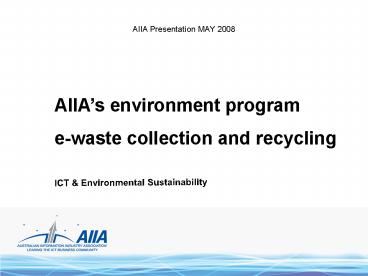AIIAs environment program - PowerPoint PPT Presentation
1 / 13
Title:
AIIAs environment program
Description:
smart product design: developing a life-cycle approach and considering end-of-life ... Apple, Canon, Dell, Epson, Fujitsu, Fuji-Xerox, HP, IBM, Lenovo, Lexmark. ... – PowerPoint PPT presentation
Number of Views:51
Avg rating:3.0/5.0
Title: AIIAs environment program
1
AIIA Presentation MAY 2008
AIIAs environment program e-waste collection
and recycling
ICT Environmental Sustainability
2
ICT environmental sustainability key focus
areas for AIIA and members
- Product stewardship
- smart product design developing a life-cycle
approach and considering end-of-life requirements - equipment energy efficiency regulations and
compliance standards - waste management collection, reuse, and
recycling
3
Waste management background
- AIIA has tabled a number of options for industry
recycling schemes to the EPHC since 2005 - Advanced recycling certificate and guarantee
utilising the retail point of sale - a waste levy to pay for all waste regardless of
brand and other variations on disposal fee at
local council and through taxation (a Planet Ark
and AIIA joint-proposal) - Import registry to pay for waste as it comes in
4
ICT product stewardship status
- An industry initiative to design a viable
computer equipment collection and recycling
program for Australian consumers is currently
being supported by ten global companies - Apple, Canon, Dell, Epson, Fujitsu, Fuji-Xerox,
HP, IBM, Lenovo, Lexmark.
5
Current proposal ByteBack
- Byteback is based on the willingness of the 10
participating brands to pay for the recycling of
their own brands historic and prospective waste - Life cycle partnership addressing end-of-life IT
equipment, focusing on household and SME waste. - Provides a testing model for industry to assist
in developing solutions. - Byteback is a joint initiative between
responsible manufacturers, AIIA and
Sustainability Victoria.
6
What is Byteback?
- Byteback is a free service, available to
residents and small business owners in Victoria
to dispose of end-of-life computers in a
environmentally responsible way. - It is a voluntary trial which will run for a
defined period (18 months to December 2008). - The trial also aims to recruit other industry
participants into the program.
7
Byteback objectives
- Obtain knowledge of the e-waste stream
- Provide measurable outcomes in terms of costs and
operations - Demonstrate industry leadership in priority waste
area (and increase shared responsibility). - Trial an end-to-end e-waste recycling scheme to
identify the challenges of a national scheme - Recover valuable resources
- Carbon abatement
8
Byteback user feedback
- High level of interest from the community
- Users typically became aware through
- contacting Councils,
- local papers
- word-of-mouth.
- 56 of respondents not prepared to pay / 38 up
to 5 - per item.
- 68 of users motivated to do the right thing.
- 78 of respondents would have otherwise used
hardwaste / bin for disposal.
9
AIIA list of key priorities
- First priority to encourage non-participating
brands to join Byteback. - Second priority to get government at all levels
to be actively selecting sustainable suppliers of
ICT equipment.
10
AIIA list of key priorities
- Third priority the establishment of a fair and
equitable legislative framework to ensure no free
riders and that orphan and historic waste from
whitebox are disposed of in an environmentally
responsible manner. - Fourth priority industry to work with government
and other stakeholders to take the findings from
Byteback and develop a sustainable, fair and
equitable national scheme in Australia.
11
Summary of a national industry scheme
- Each manufacturer responsible for own products
- User pays (included in product cost)
- Registration at point of import (narrowest point
and addresses everybody) - 100 companies
responsible for 90 of imports - Scaleable for national coverage, can co-exist
with other take-back schemes
12
Summary of a national industry scheme
- The keys to long term viability
- a call for a National Register of participants
- use of Customs data to monitor participation
- product stewardship agreements
- strong legislative enforcement
- an up-front charge on importers to cover waste
from whitebox products - policy framework established to facilitate
engagement with other stakeholders
13
Policy Framework (stakeholder engagement)































